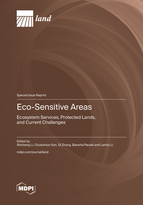Eco-Sensitive Areas: Ecosystem Services, Protected Lands, and Current Challenges
A special issue of Land (ISSN 2073-445X). This special issue belongs to the section "Landscape Ecology".
Deadline for manuscript submissions: closed (28 February 2023) | Viewed by 24828
Special Issue Editors
Interests: land use and land cover change; Tibetan Plateau; ecosystem services; protected areas
Special Issues, Collections and Topics in MDPI journals
Interests: ecosystem services assessment; land use change impact on ecosystem services
Interests: land use change; remote sensing; social-ecological systems; forest livelihoods
Interests: land use; land cover; land resources; ecosystem services; remote sensing; geography; GIS; UAV; climate change
Special Issues, Collections and Topics in MDPI journals
Special Issue Information
Dear Colleagues,
There are many eco-sensitive areas, such as mountain regions (e.g., the Tibetan Plateau) and transitional zones (e.g., farming-pastoral zone), around the world that cover a sizeable area of the Earth’s terrestrial surface. These regions provide products and services to large amounts, if not all, of the world's population, including freshwater, food, and recreation, etc. However, due to excessive human land use activities and climate change, these regions are currently facing numerous challenges that affect the structure, quality, and ability of these ecosystems to provide services and products. In response to these challenges, we have formulated many policies and have taken many actions, including designating protected land areas and ecological compensation, to balance the relationship between ecological protection and socio-economic development. These interventions must be supported by the government at different levels to ensure that these ecosystems are able to sustainably provide their services. Because of this, studies related to ecosystem services should play an essential role in managing and conserving eco-sensitive areas and protected land. However, it is still unclear how studies on ecosystem services can support biodiversity conservation under present and future scenarios.
This Special Issue aims to address critical knowledge gaps on our basic understanding of land use/cover change, ecosystem services and how they have changed in eco-sensitive areas, and societal trends in and outside of eco-sensitive areas for dealing with future challenges. A particular focus is placed on studies regarding protected land and that are interested in the management and preservation of biodiversity and landscapes in these areas.
For this Special Issue of Land, we invite authors to submit theoretical considerations and descriptions of practical case studies concerning ecosystem services and protected lands in eco-sensitive areas. Both review and research articles are welcome. Potential topics include, but not limited to, the following:
- The mapping, quantification, and assessment of ecosystem services and their dynamics;
- The assessment of the effectiveness of protected lands due to protection and restoration;
- The optimization of the layout of protected lands for enhancing the delivery of ecosystem services;
- The identification of eco-sensitive areas from the perspective of ecosystem services and remote sensing;
- The land use and trade-offs of ecosystem services;
- The identification of external threats to eco-sensitive areas.
Dr. Shicheng Li
Dr. Chuanzhun Sun
Dr. Qi Zhang
Dr. Basanta Paudel
Dr. Lanhui Li
Guest Editors
Manuscript Submission Information
Manuscripts should be submitted online at www.mdpi.com by registering and logging in to this website. Once you are registered, click here to go to the submission form. Manuscripts can be submitted until the deadline. All submissions that pass pre-check are peer-reviewed. Accepted papers will be published continuously in the journal (as soon as accepted) and will be listed together on the special issue website. Research articles, review articles as well as short communications are invited. For planned papers, a title and short abstract (about 100 words) can be sent to the Editorial Office for announcement on this website.
Submitted manuscripts should not have been published previously, nor be under consideration for publication elsewhere (except conference proceedings papers). All manuscripts are thoroughly refereed through a single-blind peer-review process. A guide for authors and other relevant information for submission of manuscripts is available on the Instructions for Authors page. Land is an international peer-reviewed open access monthly journal published by MDPI.
Please visit the Instructions for Authors page before submitting a manuscript. The Article Processing Charge (APC) for publication in this open access journal is 2600 CHF (Swiss Francs). Submitted papers should be well formatted and use good English. Authors may use MDPI's English editing service prior to publication or during author revisions.
Keywords
- ecosystem services
- protected lands
- eco-sensitive areas
- Tibetan Plateau
- land use/cover change
- ecological compensation
- anthropogenic activities
- ecosystem restoration
- ecosystem services trade-off









